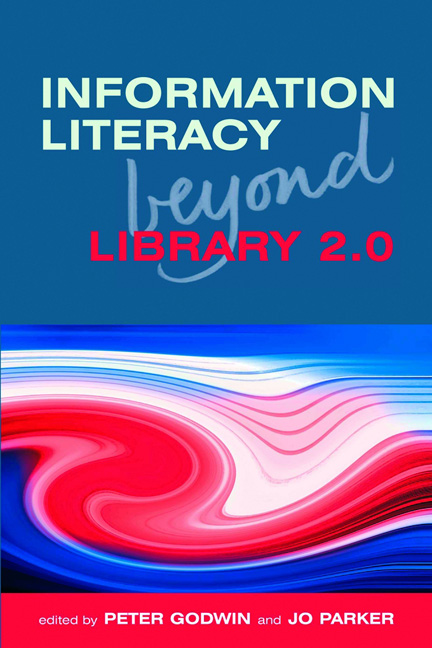Book contents
- Frontmatter
- Contents
- Contributors
- Acknowledgements
- Introduction
- PART 1 RECENT DEVELOPMENTS IN INFORMATION LITERACY AND LIBRARY 2.0
- 1 Library 2.0: a retrospective
- 2 Information literacy and Library 2.0: an update
- 3 The story so far: progress in Web 2.0 and information literacy
- 4 The changing web: sites to social
- 5 Web 2.0: from information literacy to transliteracy
- 6 Informed learning in online environments: supporting the higher education curriculum beyond Web 2.0
- PART 2 CASE STUDIES
- PART 3 WHAT IT MEANS FOR INFORMATION PROFESSIONALS
- Index
6 - Informed learning in online environments: supporting the higher education curriculum beyond Web 2.0
from PART 1 - RECENT DEVELOPMENTS IN INFORMATION LITERACY AND LIBRARY 2.0
Published online by Cambridge University Press: 09 June 2018
- Frontmatter
- Contents
- Contributors
- Acknowledgements
- Introduction
- PART 1 RECENT DEVELOPMENTS IN INFORMATION LITERACY AND LIBRARY 2.0
- 1 Library 2.0: a retrospective
- 2 Information literacy and Library 2.0: an update
- 3 The story so far: progress in Web 2.0 and information literacy
- 4 The changing web: sites to social
- 5 Web 2.0: from information literacy to transliteracy
- 6 Informed learning in online environments: supporting the higher education curriculum beyond Web 2.0
- PART 2 CASE STUDIES
- PART 3 WHAT IT MEANS FOR INFORMATION PROFESSIONALS
- Index
Summary
Introduction
As boundaries between physical and online learning spaces become increasingly blurred in higher education (HE), how can students gain the full benefit of Web 2.0 social media and mobile technologies for learning? How can we, as information professionals and educators, best support the information literacy (IL) learning needs of students who are universally mobile and Google focused? This chapter presents informed learning as a pedagogical construct with potential to support learning across the HE curriculum, for Web 2.0 and beyond.
Informed learning (Bruce, 2008) responds flexibly to the dynamic information-learning environment of HE, embracing the opportunities of learning and teaching with new and emerging media. It supports a holistic learning approach whereby students consciously engage in a process of using information to learn specific content or practices. By promoting enquiry and problem solving, and the adoption of discipline- or context-specific knowledge and practices, it enables learners to develop the flexibility and confidence to use information in constantly evolving information environments. In this way, informed learning shifts the focus of IL education from mastering information skills to using information critically, ethically and creatively to learn within the wider context of students’ disciplinary learning.
After outlining the principles of informed learning and how they may enrich the HE curriculum, we explain the role of library and information professionals in promoting informed learning for Web 2.0 and beyond. Then, by way of illustration, we describe recent experience at an American university where librarians simultaneously learned about and applied informed learning principles in reshaping the IL programme.
Informed learning for the online-intensive HE information-learning environment
The contemporary HE information-learning environment is online intensive and dispersed. Learners and educators are culturally and socially diverse and often physically remote from their institution's home campus. They have access to an ever-widening range of Web 2.0 resources from myriad international and local sources, way beyond the controlled environs of their institution's learning management systems (LMS) such as Blackboard and Moodle. Since Web 2.0 media are in a constant flux of evolution and extinction, students need to develop the confidence and flexibility to take the changes in their stride. However, while contemporary learners (of all ages) are increasingly IT savvy, they tend to demonstrate quite limited critical and strategic approaches and tend to rely on familiar, popular tools such as Google (Head and Eisenberg, 2010; Hughes, 2009; Lorenzo and Dziuban, 2006).
- Type
- Chapter
- Information
- Information Literacy Beyond Library 2.0 , pp. 65 - 80Publisher: FacetPrint publication year: 2012
- 3
- Cited by



